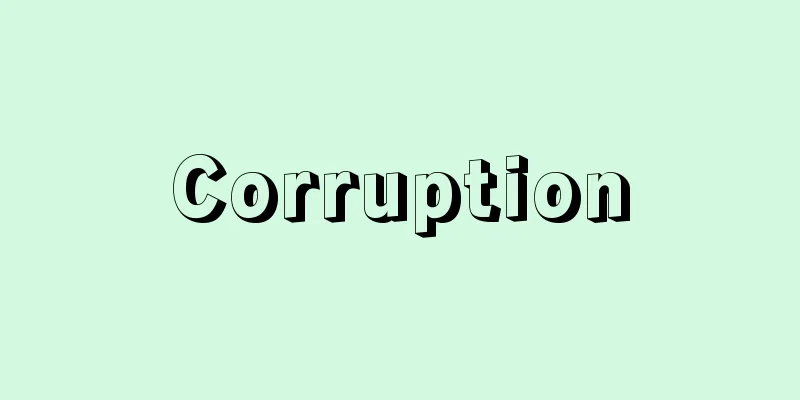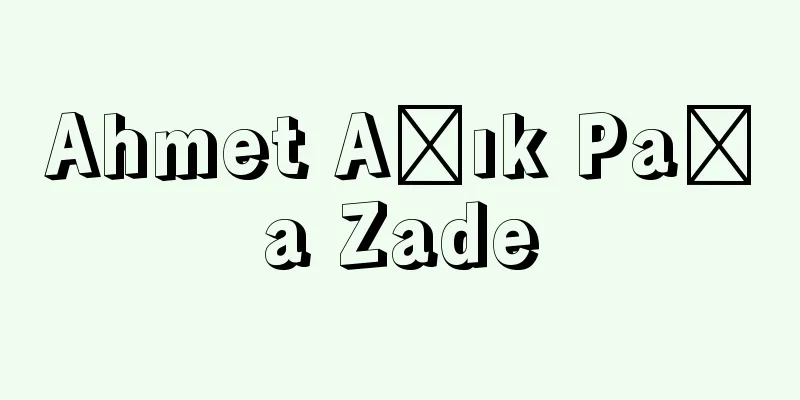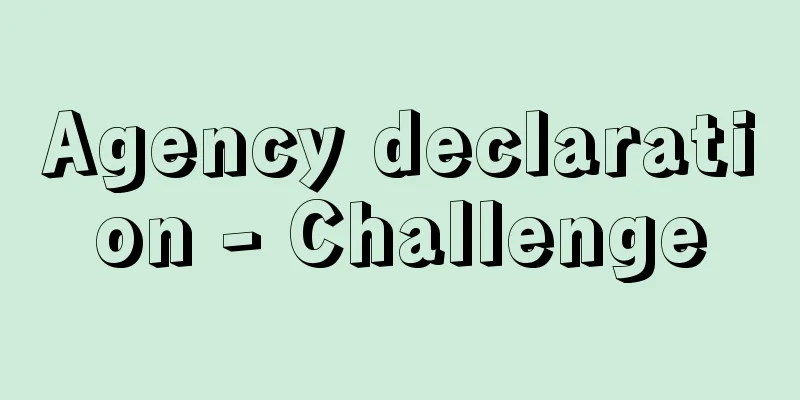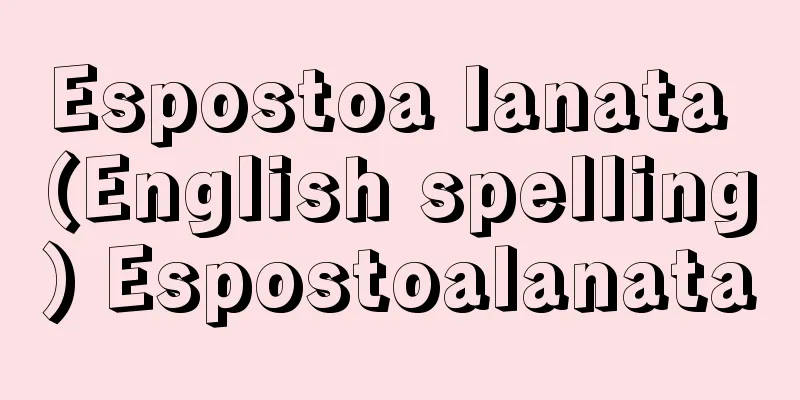Corruption

|
An act by a public official to seek personal gain by abusing his/her position or official authority. Originally, this word was equivalent to the term "tokushoku" (corruption) in the old Criminal Code, but after World War II, due to restrictions on the use of kanji, it became common to write it as "corruption," and in the 1995 (Heisei 7) Criminal Code revision, "tokushoku" was changed to "corruption." Before the war, police slang for "sansui" generally referred to "corruption," that is, acts of corrupting public office, such as embezzlement, blackmail, abuse of authority, and bribery, but after the war, it came to mean "corruption" (the word "sansui" was also used until around the 1950s) and therefore bribery. [Tetsuro Murofushi and Jin Igarashi] Legal definitionThe crime of corruption in the Penal Code includes both abuse of authority and bribery, but corruption is often used to refer to bribery alone. The central and fundamental provision of the Japanese Penal Code, Article 197, Paragraph 1, first paragraph, states that "When a public official or arbitrator accepts, demands or promises a bribe in the course of his/her duties, he/she shall be punished with imprisonment for not more than five years. In such a case, if he/she accepts a request, he/she shall be punished with imprisonment for not more than seven years." The necessary conditions for corruption, i.e., the crime of bribery, in this provision are (1) a public official (or arbitrator), (2) in the course of his/her duties (official authority, official act), (3) a bribe (necessary knowledge of this), and (4) acceptance (or demand or promise). In addition, in the case of the crime of accepting a bribe, another condition (5) a request (a favor) is added, and the punishment is increased to "imprisonment for not more than seven years." [Tetsuro Murofushi and Jin Igarashi] The Seventeen-Article Constitution and CorruptionJapan also has a long history of corruption. Article 5 of Prince Shotoku's Seventeen-Article Constitution states, "These days, those who settle lawsuits are accustomed to taking advantage of profits, and when they see someone trying to bribe, they listen to what is being said." This shows that the officials who handled lawsuits at that time were taking bribes. Furthermore, the Office Regulations of the Taiho Code (701) stipulated that bribery was a crime of perverting the law by officials with official authority who accepted money, and set maximum penalties ranging from 80 strokes with a cane for every shaku of bribe material to being strangled with 30 pieces of cloth (death penalty). In addition, for non-perverting law, which does not accept money and do not pervert the law, the maximum penalty was exile (exile). The names of the crimes of perversion and non-perversion from a thousand years ago remained in the New Laws and Revised Laws of the Meiji Period, which were in effect until 1881 (Meiji 14). The term malice came into widespread use after the promulgation of the Malice Law (for council members, members, committee members, or representatives elected or appointed by law) in 1901 and the enforcement of the Criminal Code in 1908, which defined the crime of malice. [Tetsuro Murofushi and Jin Igarashi] From modern times to the present: the emergence of scandalsFrom the Meiji period through the Taisho and early Showa periods up until Japan's defeat in the Pacific War, corruption, caused by public servants' private ownership of their public positions and low salaries, continued unabated, resulting in corruption and scandals of all sizes. Generally, a large-scale corruption case that becomes a political issue is called a "sagigoku," but before World War II, it was relatively often called a "sagigoku" (although it depends on how the term is used), and small-scale so-called "window corruption" that was traded at the grassroots level was not noticeable. In addition, public officials (civil servants) at that time had a sense of privilege under the Emperor System, which was said to have resulted in restricting their morals. After World War II, the number of cases of corruption far increased compared to the prewar period, and corruption was "democratized" and spread, giving rise to popular phrases such as the "Five Cells" ("Nomaseru, Tabereru, Sharaseru, Bosaraseru, Hakaseru"), which refer to acts of bribery caused by collusion between the company-related groups (contractors and companies) and the official-related groups (official officials). The reasons for the sharp increase in corruption after World War II, during the period of chaos immediately following the defeat, include the following: (1) The notion of private ownership of public offices, a remnant of the prewar patrimonial bureaucracy, still lingered. (2) Bureaucrats were freed from the sense of privilege they felt under the Emperor System and abandoned their pretense of morality. (3) The hardships facing low-paid civil servants as their livelihoods are unable to keep up with the rapid inflation. (4) The occupying forces' policy was indirect rule through the Japanese government, and enormous power was delegated to bureaucrats. (5) The inertia of the transactions of interests between the military, bureaucrats and munitions companies that had been fostered during the controlled economy during the war continued even during the controlled economy after the war. (6) The controlled companies that were established during the war were transformed into public corporations and other entities, and the proliferation of special corporations that were easy targets for bureaucrats transferring to other positions and inducing profits became breeding grounds for corruption. (7) As a result of the occupying forces' dissolution of the zaibatsu conglomerates and anti-monopoly measures, many companies were forced to rely more heavily on government funding, and public authority increasingly intervened in companies through government loans and subsidies. (8) Information about corruption among civil servants, which tended to be kept secret before the war (during the war, corruption in the military was not made public), was now made public. [Tetsuro Murofushi and Jin Igarashi] Structured corruptionEven today, more than half a century after the Second World War, corruption among civil servants continues to occur. In addition to the above-mentioned causes, which have continued to have their effects to a greater or lesser extent, there is another major characteristic. Since the conservative merger in 1955 (Showa 30) at the request of the business world, we have not had a healthy parliamentary democracy in which the ruling and opposition parties have been alternately in power for a long time. Because of the long-term de facto conservative one-party dictatorship (or coalition government), it has become difficult for civil servants, from high-ranking bureaucrats in the central and local government to the lowest levels of administration, to maintain neutrality. As a result, bureaucrats have played the role of intermediaries between the ruling government party (political world), which is seen as the political spokesperson for the political parties that expanded their influence after the war, especially the business world that provides political funds, and the companies (business world), mainly monopolies that are parasitic on the distribution of government financial funds or the policies and measures of the state. This is the so-called collusion structure between politicians, bureaucrats, and business leaders, and within this, the elements of a bribery case have been cleverly slipped through the legal net, and despite the existence of corrupt situations, the ruling party, which holds a majority in the legislature, has avoided and postponed the enactment of strict anti-corruption or vested interests bills, and has made it so that it does not become a criminal corruption case. In this way, the power structure has become sanctified and privileged, and the flow of money has become legalized and systematized. Critic Tetsuro Murofushi has named this structural corruption, and a typical example of structural corruption, including fiscal investment and loans, is related to public works-related expenses (9.2% of the national budget in fiscal 2009) that are spent under the pretext of social capital development such as forestry and flood control measures, environmental and housing measures, and regional development. In Japan, known as a construction nation, politicians, bureaucrats, and construction companies are one and the same, and financial institutions have also joined in, creating a system called the "construction-government complex," not a military-industrial complex. In Japan, contractors for public construction contracts collude in advance, set the bid price and profit distribution, and then fraudulently win the construction contract in a formal bid (a crime that violates Article 96 of the Criminal Code. Contractors who collude and drop out of the bid are given the reserved profit distribution after the bid is won, a bad habit that is delaying the establishment of a modern contract society) is commonplace under the so-called "voice of heaven" of politicians and administrative heads, and public works funds are distorted and spent. In the process, along with raising funds to collect votes to maintain the Conservative Party government, a rigid structural corruption system has been formed and is believed to have been incorporated into Japan's ruling system. In the area of national and public budgets, we also see the abuse of various licensing and approval powers of government agencies by so-called "tribal politicians," high-ranking bureaucrats, industry, academic societies, etc. In addition, there is collusion with various external organizations and related companies under their guidance and supervision, and similar structural vested interests are constantly arising through the allocation of public funds. However, the long-standing problems began to show obvious cracks from the late 1980s to the 1990s, with the Recruit Scandal (1988-1989), the Kyowa Scandal (1991), the Tokyo Sagawa Kyubin Scandal (1992), the uncovering of corruption in general construction companies in which cabinet-level politicians and local government heads were arrested one after another (1993-1994), and corruption in the Ministry of Health, Labor and Welfare (1996), which was then a link between the central government and academic societies. Furthermore, from 1997 to 1999, political corruption and corruption by financial institutions and related bureaucrats under the so-called convoy system of overprotective administration by the former Ministry of Finance, including the Bank of Japan and government-affiliated financial institutions, was uncovered one after another, and in the 142nd Diet session in 1998, the ruling and opposition parties submitted a bill on the ethics of national public servants. In August 2009, a change of government was realized between the ruling and opposition parties, and a coalition government led by the Democratic Party was born. However, financial scandals involving the two top leaders of the new administration, Prime Minister Yukio Hatoyama and Secretary-General Ichiro Ozawa, became major issues, demonstrating that a change of government alone is not enough to fundamentally deter corruption. As a result, the question was raised as to whether the establishment of political leadership could change the relationship between politicians and bureaucrats that creates vested interests and eradicate structural corruption at its roots. [Tetsuro Murofushi and Jin Igarashi] "The Structure of Corruption, by Murofushi Tetsuro (Iwanami Shinsho)" ▽ "An Introduction to Corruption Studies, by Murofushi Tetsuro (1976, Pep Publishing)" ▽ "The Structure of Corruption, by Sekiguchi Takao (1980, Shiobunsha)" ▽ "The 100-Year History of Corruption, edited by Matsumoto Seicho (1977, Yomiuri Shimbun)" ▽ "The True Story of Japanese Corruption, by Murofushi Tetsuro (Chikuma Bunko)" ▽ "Murofushi Tetsuro's Exploration of Corruption Around the World, by Murofushi Tetsuro (1996, Sanshusha)" [References] | | | | | | | | | | | | | | |Source: Shogakukan Encyclopedia Nipponica About Encyclopedia Nipponica Information | Legend |
|
公務員が地位や職務上の権限を濫用して私的利益を図る行為。もともとこのことばは、かつての刑法でいう涜職(とくしょく)にあたるが、第二次世界大戦後、漢字制限のため汚職と書くのが一般的になり、1995年(平成7)の刑法改正で涜職から汚職に改められた。戦前は、警察官の隠語でサンズイといえば普通、涜職つまり横領、恐喝、職権濫用、贈収賄など官職を涜(けが)す行為をさしたが、戦後は、汚職(昭和30年代ごろまではサンズイということばも使われた)即贈収賄をさすようになった。 [室伏哲郎・五十嵐仁] 法律上の定義刑法の汚職の罪は、職権濫用罪と賄賂(わいろ)罪をあわせているが、普通、汚職は賄賂罪だけをさしていうことが多い。日本の刑法の賄賂罪の中心的な基本条文、第197条1項前段は「公務員又は仲裁人が、その職務に関し、賄賂を収受し、又はその要求若(も)しくは約束をしたときは、五年以下の懲役に処する。この場合において、請託を受けたときは、七年以下の懲役に処する」と規定している。この条文のうち汚職、すなわち収賄罪を構成する必要条件は、(1)公務員(または仲裁人)、(2)その職務に関し(職務権限、職務行為)、(3)賄賂(この認識が必要)、(4)収受(または要求、もしくは約束)の四つである。また、受託収賄罪の場合は、これにもう一つ(5)請託(依頼。頼みごと)が加わり、「七年以下の懲役」と刑が重くなっている。 [室伏哲郎・五十嵐仁] 十七条憲法と汚職日本でも汚職の歴史は古い。聖徳太子の十七条憲法第5条には「頃(このごろ)訟(うたへ)を治(をさ)むる者(ひとども)、利(くほさ)を得て常とし、賂(まひなひ)を見ては讞(ことわりまう)すを聴く」とある。訴訟を扱う当時の役人が賄賂をとっていたことがわかる。さらに、大宝律令(たいほうりつりょう)(701)の職制律では、賄賂罪については、枉法臓(おうほうぞう)、つまり職務権限のある役人が財を受けて法を枉(ま)げる罪を規定し、収賄物品布1尺で杖(じょう)八十(杖で80回打つ)から布30端(反)で絞(こう)(死刑)の極刑までが定められていた。また、財を受けて法を枉げない不枉法臓についても、最高刑は流(る)(流罪)までの規定があった。1881年(明治14)まで有効であった明治の新律綱領や改定律例には、この千数百年前の枉法臓や不枉法臓の罪名がそのまま残っていた。涜職という用語は、1901年の(法令ニ依リ選挙又ハ任用シタル議員・会員・委員又ハ総代等ノ)涜職法公布、および1908年の涜職罪を規定した刑法施行以降、広く用いられるようになったのである。 [室伏哲郎・五十嵐仁] 近代から現代へ――疑獄の発生明治以後、大正、昭和前期の太平洋戦争敗戦までの期間も、公務員の公職私有観や俸給の低さなどを背景とする汚職は後を絶たず、大小の汚職、疑獄事件が起こっている。一般に、政治問題化した大規模な汚職事件を疑獄というが、第二次世界大戦前は比較的疑獄(用語の使い方にもよるが)と称される場合が多く、末端行政で取引される小規模のいわゆる窓口汚職は目だたなかった。また、当時の官公吏(公務員)は天皇制下の特権意識もあって、それが結果としてモラルを拘束しているともいわれた。 第二次世界大戦後は、汚職の数が戦前に比べてはるかに多くなり、汚職の「民主化」拡散が行われ、社用族(業者、企業側)と公用族(役人側)の癒着による贈収賄行為「飲まセル、食わセル、握らセル、威張らセル、抱かセル」の「五セル」などの流行語も生み出した。第二次世界大戦後、汚職が激増した理由としては、敗戦直後の混乱期には、以下のものがあげられる。 (1)戦前の家産制官僚制の残滓(ざんし)である公職私有観がまだ尾を引いていた。 (2)官僚が天皇制下の特権意識から解放され、たてまえの道徳意識を捨てた。 (3)激しいインフレに追いつかない薄給公務員の生活上の困窮。 (4)占領軍の政策が日本政府を通じる間接統治方式で、官僚に強大な権限が委任された。 (5)戦時中、統制経済の間に醸成された軍部・官僚と軍需会社間の利権取引の惰性が、戦後の統制経済期間中も続いた。 (6)戦争中の統制会社が公団などになり、官僚の天下りによる利益誘導が行われやすい特殊法人の乱立が、汚職の温床となった。 (7)占領軍の財閥解体、独占禁止などにより、弱小資本乱立の形となった多くの企業が、政府資金に頼る比重が多くなり、政府融資、補助金などを通じて、企業への公権力の介入が増大した。 (8)戦前は秘匿されがちだった公務員の汚職(戦時中、軍部の汚職は公表されなかった)に関する情報がオープンになった。 [室伏哲郎・五十嵐仁] 構造汚職第二次世界大戦後半世紀以上たった今日も、相変わらず公務員の汚職は跡を絶たないが、それは前記の諸原因が、様相を変えているものの大なり小なり尾を引いていることのほかに、もう一つ大きな特徴を付け加えている。それは、財界の要請による1955年(昭和30)の保守合同以来、長く与野党が政権交替をするという健全な議会制民主主義の運営が行われてこなかった点である。事実上の保守一党長期独裁(あるいは連立による)政権が続いたため、中央、地方行政府の高級官僚以下、行政の末端に至るまで、公務員が中立を保つことが困難になっている。その結果、官僚は、戦後その勢力を拡大した政党、とくに政治資金を提供する財界の政治的代弁人とみられる政府与党(政界)と、政府の財政資金の散布あるいは国家の政策・施策に寄生依存する独占企業を中心とする企業(財界)との媒介者としての役割を演じてきた。いわゆる政・官・財の癒着構造がこれで、このなかで、贈収賄事件の構成要件を巧みに法の網の目から逃し、汚職的状況が存在するにもかかわらず、立法府の多数を占める政権与党が厳正な汚職もしくは利権禁止法案の立法を回避、先送りするために刑法上の汚職事件にはならないとしてきた。このように権力構造の聖域化、特権化、金の流れの合法化、体系化が定着するに至った。評論家の室伏哲郎はこれを構造汚職と命名したが、構造汚職の典型的な事例は、財政投融資を含めれば、治山治水対策、環境・住宅対策などの社会資本整備や地方開発などの名目で支出される公共事業関係費(2009年度は、国家予算の9.2%)にかかわるものである。 土建国家といわれる日本では、政治家、官僚、建設業者が三位(さんみ)一体となり、さらに、金融機関が加わった軍産複合体ならぬ「建政複合体」という仕組みが存在する。そこでは、公の工事請負で請負人たちがあらかじめ談合のうえ、入札価格や利益配分を定めて形式的な入札で工事を不正落札する談合入札(刑法96条違反の罪。談合で入札を降りた業者には落札後予約した利益分配分をわけるなど、日本的「和」の慣習で近代契約社会の成立を遅らせている悪弊)が、政治家や行政首長などのいわゆる「天の声」の下で日常茶飯事となり、ゆがんだ形での公共事業費の散布・費消が行われる。その過程で、保守党政権を維持するための集票費用の捻出(ねんしゅつ)とともに、牢乎(ろうこ)とした構造汚職体系が形成され、日本の支配機構のなかに組み込まれてきたとみられる。国家・公共予算の分野では、いわゆる族議員、高級官僚、業界、学会などによる官公庁の各種許認可権の利用もみられる。また、その指導・監督の下にある各種外郭団体や関連企業などとの癒着がみられ、公的資金の予算分配を通して、同様の構造的な利権の発生を恒常的にしている。 しかし、積年の弊は1980年代末から1990年代に顕著な綻(ほころ)びをみせ、リクルート事件(1988~1989)、共和事件(1991)、東京佐川急便事件(1992)、閣僚級の政治家や地方自治体の首長が相次いで検挙されたゼネコン汚職の摘発(1993~1994)、中央官庁と学会を結ぶ当時の厚生省の汚職(1996)などが発生した。さらには1997年から1999年にかけて、日銀、政府系金融機関を含む旧大蔵省のいわゆる護送船団方式という過保護行政下での金融機関と関連官僚の政治的腐敗や汚職が続々と摘発されるに至り、1998年の第142回国会には国家公務員倫理法案が与野党より提出された。2009年8月に与野党の政権交代が実現し、民主党主導による連立政権が誕生した。しかし新政権の2トップである鳩山由起夫首相と小沢一郎幹事長に関連する金銭スキャンダルが大きな問題となり、政権交代だけでは汚職の根本的な抑止力とはならないことが示された。その結果、政治の主導性を確立することによって、利権を生み出す政治家と官僚の関係を変え、構造汚職の根を絶つことができるかどうかが問われることとなった。 [室伏哲郎・五十嵐仁] 『室伏哲郎著『汚職の構造』(岩波新書)』▽『室伏哲郎著『汚職学入門』(1976・ペップ出版)』▽『関口孝夫著『汚職の構造学』(1980・汐文社)』▽『松本清張編『疑獄100年史』(1977・読売新聞社)』▽『室伏哲郎著『実録 日本汚職史』(ちくま文庫)』▽『室伏哲郎著『室伏哲郎の世界汚職探検』(1996・三修社)』 [参照項目] | | | | | | | | | | | | | | | |出典 小学館 日本大百科全書(ニッポニカ)日本大百科全書(ニッポニカ)について 情報 | 凡例 |
Recommend
Tax evader - datsuzeihan
An act that reduces tax revenue for national and l...
Dry Conduction Method
...There are two methods for artificial egg colle...
Pink Queen
...They bloom in the evening and wilt on the seco...
Iida Line
The name of the Central Japan Railway Company'...
Seigan Yanagawa
Year of death: September 2, 1858 (October 8, 1858)...
Epistle of Ignatius
The seven letters written by Ignatius, the second ...
Brokerage - Shusen
〘noun〙① (━suru) To perform a certain action in fro...
Copts - Koputo (English spelling)
Native Egyptian Christians. This term was born fr...
Basf [company] - Basf
A German chemical company. Founded in Mannheim in ...
Orient [seed] - Orient
... Well-drained soil and abundant sunshine are d...
Vireya
…Unlike Japanese rhododendrons, Western rhododend...
Thin-headed Caddisfly - Thin-headed Caddisfly
...The representative species known from Japan ar...
Colchicum
A genus of the lily family, it is a bulbous plant ...
Masanosuke Sufu
Year of death: September 26, 1864 (October 26, 186...
Review of Reviews
…He was condemned in parliament as a pornographer...









